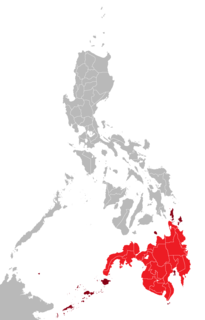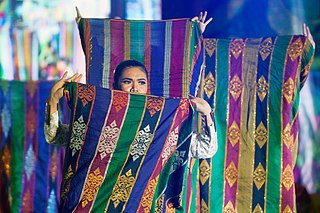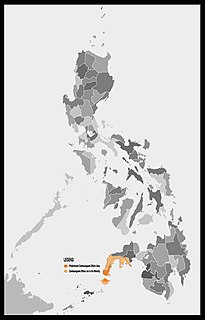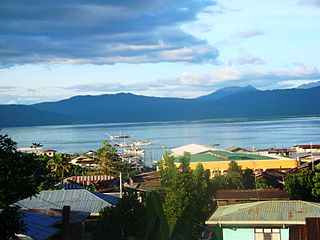
Mindanao is the second-largest island in the Philippines, after Luzon and seventh-most populous island in the world. Located in the southern region of the archipelago, the island is part of an island group of the same name that also includes its adjacent islands, notably the Sulu Archipelago. According to the 2020 census, Mindanao has a population of 26,252,442 people, while the entire island group has an estimated population of 27,021,036 according to the 2021 census.

Zamboanga del Norte (Chavacano: Zamboanga del Norte; Cebuano: Amihanang Zamboanga; Subanon: Utara Sembwangan; Tagalog: Hilagang Zamboanga), officially the Province of Zamboanga del Norte, is a province in the Philippines situated within the Zamboanga Peninsula region in Mindanao. Its capital is Dipolog and the province borders Zamboanga del Sur and Zamboanga Sibugay to the south, Misamis Occidental to the east, and the Sulu Sea to the west.

Chavacano or Chabacano[tʃabaˈkano] is a group of Spanish-based creole language varieties spoken in the Philippines. The variety spoken in Zamboanga City, located in the southern Philippine island group of Mindanao, has the highest concentration of speakers. Other currently existing varieties are found in Cavite City and Ternate, located in the Cavite province on the island of Luzon. Chavacano is the only Spanish-based creole in Asia.

Maranao is an Austronesian language spoken by the Maranao people in the provinces of Lanao del Norte and Lanao del Sur in the Philippines, and in Sabah, Malaysia.

The Maranao people, also spelled Meranao, Maranaw, and Mëranaw, is the term used by the Philippine government to refer to the southern indigenous people who are the "people of the lake", a predominantly-Muslim Lanao province region of the Philippine island of Mindanao. They are known for their artwork, weaving, wood, plastic and metal crafts and epic literature, the Darangen. They are ethnically and culturally closely related to the Iranun, and Maguindanao, all three groups being denoted as speaking Danao languages and giving name to the island of Mindanao.

Salug, officially the Municipality of Salug, is a 3rd class municipality in the province of Zamboanga del Norte, Philippines. As of the 2020 census, it had a population of 32,134 people.

Lapuyan, is a 3rd class municipality in the province of Zamboanga del Sur, Philippines. According to the 2020 census, it has a population of 27,737 people. The municipality of Lapuyan is located in the southern section of the Zamboanga del Sur province. It is also often referred to as "Little America".

The Lumad are a group of Austronesian indigenous people in the southern Philippines. It is a Cebuano term meaning "native" or "indigenous". The term is short for Katawhang Lumad, the autonym officially adopted by the delegates of the Lumad Mindanao Peoples Federation (LMPF) founding assembly on 26 June 1986 at the Guadalupe Formation Center, Balindog, Kidapawan, Cotabato, Philippines. Usage of the term was accepted in Philippine jurisprudence when President Corazon Aquino signed into law Republic Act 6734, where the word was used in Art. XIII sec. 8(2) to distinguish Lumad ethnic communities from the Bangsamoro.

The Zamboangueño people are a creole ethnolinguistic nation of the Philippines originating in Zamboanga City. Spanish censuses record that as much as one-third of the inhabitants of the city of Zamboanga possess varying degrees of Iberian and Hispanic-American admixture. In addition to this, select cities such as Iloilo, Bacolod, Dumaguete, Cebu, and Cavite, which were home to military fortifications and/or commercial ports during the Spanish era also hold sizable mestizo communities.

The Subanon is an indigenous group to the Zamboanga peninsula area, particularly living in the mountainous areas of Zamboanga del Sur and Misamis Occidental, Mindanao Island, Philippines. The Subanon people speak Subanon languages. The name is derived from the word soba or suba, a word common in Sulu, Visayas, and Mindanao, which means "river", and the suffix -nun or -non, which indicates a locality or place of origin. Accordingly, the name Subanon means "a person or people of the river". These people originally lived in the low-lying areas. However, due to disturbances and competitions from other settlers like the Moros, and migrations of Cebuano speakers to the coastal areas attracted by the inviting land tenure laws, further pushed the Subanon into the interior.
The Subanen languages are a group of closely related Austronesian languages belonging to the Greater Central Philippine subgroup. Often described as a single language, they are considered by linguists as a dialect cluster more than a monolithic language. Subanen languages are spoken in various areas of Zamboanga Peninsula, namely the provinces of Zamboanga Sibugay, Zamboanga del Norte and Zamboanga del Sur, and in Misamis Occidental of Northern Mindanao. There is also a sizeable Subanen community in Misamis Oriental. Most speakers of Subanen languages go by the name of Subanen, Subanon or Subanun, while those who adhere to Islam refer to themselves as Kalibugan.
The Canatuan mine was a gold/silver, copper/zinc open-pit mine located in the province of Zamboanga del Norte on the southern island of Mindanao, Philippines. The mine was operated from 2004 to January 2014 by TVI Resource Development (Phils) Inc., a former subsidiary of Canadian-based TVI Pacific Inc. The mine was operated within Mount Canatuan, a sacred mountain of the Subanen people, who protested against the mining company and its operations.
Western Subanon is an Austronesian language belonging Subanen branch of the Greater Central Philippine subgroup. It is spoken by c. 300,000 people in the southwestern part of the Zamboanga Peninsula region of Mindanao.
Timuay Lucenio Manda is a Thimuay or ancestral leader of the indigenous Subanon people of the Zamboanga peninsula in the Philippines. He also serves as a government official, being the Barangay (village) captain of Barangay Conacon in the municipality of Bayog, Zamboanga del Sur. He is known as an opponent of illegal mining and logging operations in the Philippines.
Barangay de Ayala, or more commonly Ayala, is one of the 98 barangays in Zamboanga City. It is located 16.5 kilometers west of the city proper and is easily accessible by land and sea. Generally regarded by Zamboangueños as one of the most developed barrios in the west coast, Ayala spans 5.29 square kilometers wide and houses several canning factories.

Dumanquilas Bay is an arm of the Moro Gulf on the southern side of the Zamboanga Peninsula in western Mindanao island in the Philippines. It is shared between the provinces of Zamboanga del Sur on the eastern and northern shore, and Zamboanga Sibugay on the western shore. An irregularly shaped peninsula extending to Flecha Point separates it from Pagadian Bay to the east, while to the west, the bay connects with Sibuguey Bay through Canalizo Strait which separates Olutanga island from the mainland of Zamboanga. Politically, it is divided between the Zamboanga del Sur municipalities of Margosatubig, Vincenzo Sagun, Lapuyan and Kumalarang, and the Zamboangay Sibugay municipalities of Buug, Malangas and Alicia.
Pangasi, also known as pangase or gasi, are various traditional Filipino rice wines from the Visayas Islands and Mindanao. They could also be made from other native cereals like millet and job's tears. Pangasi and other native Filipino alcoholic beverages made from cereal grains were collectively referred to by the Spanish as pitarrillos.

The term Paramount Ruler, or sometimes Paramount Datu, is a term used by historians to describe the highest ranking political authorities in the largest lowland polities or inter-polity alliance groups in early Philippine history, most notably those in Maynila, Tondo, Pangasinan, Cebu, Bohol, Butuan, Cotabato, and Sulu.
Timuay Imbing was the Timuay or ancestral leader of the Subanen people the Zamboanga peninsula in the Philippines during the American colonial Period. One of the most prominent Thimuay in Philippine history, he is perhaps best known for his role in introducing Evangelical Protestantism, through the Christian and Missionary Alliance Churches of the Philippines, to the Subanon people, and for establishing the settlement which would become the present-day municipality of Lapuyan, Zamboanga del Sur.












